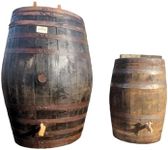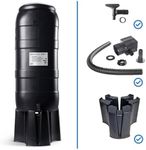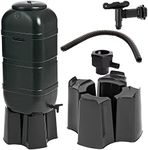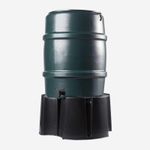Buying Guide for the Best Rain Barrels
When choosing a rain barrel, it's important to consider how it will fit into your water conservation efforts and garden needs. Rain barrels are a great way to collect and store rainwater for use in your garden, reducing your reliance on municipal water supplies and helping to conserve water. To find the best rain barrel for your needs, consider factors such as capacity, material, design, and additional features that can enhance its functionality and ease of use.CapacityCapacity refers to the amount of water a rain barrel can hold, typically measured in gallons. This is important because it determines how much rainwater you can collect and store for later use. Rain barrels come in various sizes, ranging from small 30-gallon barrels to large 100-gallon or more. To choose the right capacity, consider the size of your garden and how much water you typically use. If you have a large garden or live in an area with frequent rainfall, a larger capacity barrel may be more suitable. Conversely, a smaller garden or less frequent rainfall might mean a smaller barrel will suffice.
MaterialRain barrels are made from a variety of materials, including plastic, wood, metal, and ceramic. The material affects the durability, weight, and appearance of the barrel. Plastic barrels are lightweight, affordable, and resistant to rust and rot, making them a popular choice. Wooden barrels offer a more traditional look but require maintenance to prevent rot. Metal barrels are durable but can be prone to rust if not properly coated. Ceramic barrels are aesthetically pleasing but can be heavy and fragile. Consider the climate in your area and the aesthetic you prefer when choosing the material.
DesignThe design of a rain barrel includes its shape, color, and overall appearance. This is important for both functionality and how well it blends with your outdoor space. Some barrels are designed to be decorative and can enhance the look of your garden, while others are more utilitarian. Consider where you will place the barrel and how it will fit with your garden's design. Additionally, some designs include features like flat backs for placement against walls or stackable options for increased capacity.
Overflow and SpigotThe overflow system and spigot are crucial components of a rain barrel. The overflow system allows excess water to be diverted away from the barrel when it is full, preventing water from pooling around the base. A good overflow system is essential to prevent flooding and damage to your home's foundation. The spigot is used to access the stored water, so it should be easy to use and positioned at a convenient height. Look for barrels with a sturdy, rust-resistant spigot and a reliable overflow system to ensure efficient water management.
Additional FeaturesSome rain barrels come with additional features that can enhance their functionality. These may include built-in filters to keep debris out, linking kits to connect multiple barrels, or mosquito-proof screens to prevent insect breeding. These features can make a rain barrel more convenient and effective. Consider what additional features might be beneficial for your specific needs, such as if you live in an area with a lot of debris or mosquitoes, or if you plan to expand your rainwater collection system in the future.















